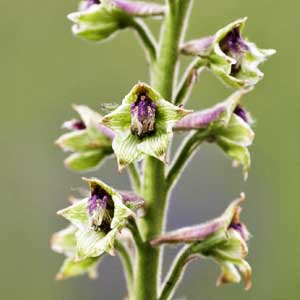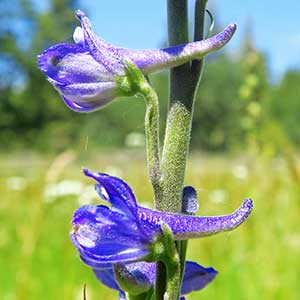Delphinium viridescens
Delphinium distichum
Wenatchee larkspur
two-spike larkspur
Basal and lower cauline leaves long-petiolate, the blades up to 10 cm. broad, divided into 3 main wedge-shaped lobes, these once or twice cleft into oblong-rounded segments; mid-cauline leaves short-petiolate and overlapping, nearly erect, divided into narrow, acute segments, abruptly transitional to the lower leaves, but gradually transitional to the linear, entire, bract-like upper leaves.
Basal and lower cauline leaves long-petiolate, the blades 4-6 cm. broad and divided nearly to the base into 3 segments, which are twice divided into broad segments; lower leaves abruptly transitional into mid-stem leaves, which are short-petiolate, very numerous and overlapping, and finely divided into linear segments.
Inflorescence usually a simple, narrow raceme, the pedicels shorter than the flowers;
sepals 5, purplish, but strongly streaked with yellow or greenish-yellow, oblanceolate, glandular, 7-11 mm. long;
spur thick, straight, 7-10 mm. long;
petals 4, yellowish or purple, the lower pair densely soft-hairy, equaling the sepals;
stamens numerous;
pistils 3.
Inflorescence a many-flowered, spike-like raceme, the pedicels shorter than the calyx spur and strongly ascending;
sepals 5, bluish-purple with lighter streaks, cupped forward, 7-9 mm long, oblong, the spur 11-17 mm. long;
petals 4, small, the lower pair blue, lobed, the upper pair white;
stamens numerous;
pistils 3.
Follicles 6-8 mm. long, erect, densely glandular-pubescent.
Follicles 8-12 mm. long, erect, usually glandular.
Delphinium viridescens
Delphinium distichum
- Local floras:
BC,
OR,
WA
- Local Web sites:
Flora NW,
PNW Herbaria
WildflowerSearch
iNaturalist (observations)
USDA Plants Database
- LBJ Wildflower Center
- SEINet
- Plants of the World Online
- Encyclopedia of Life
- Wikipedia
- Google Image Search



